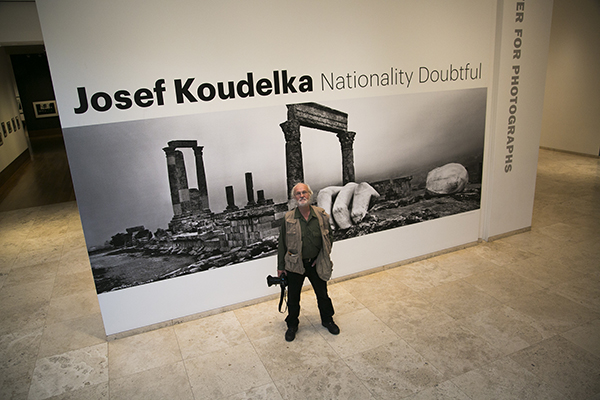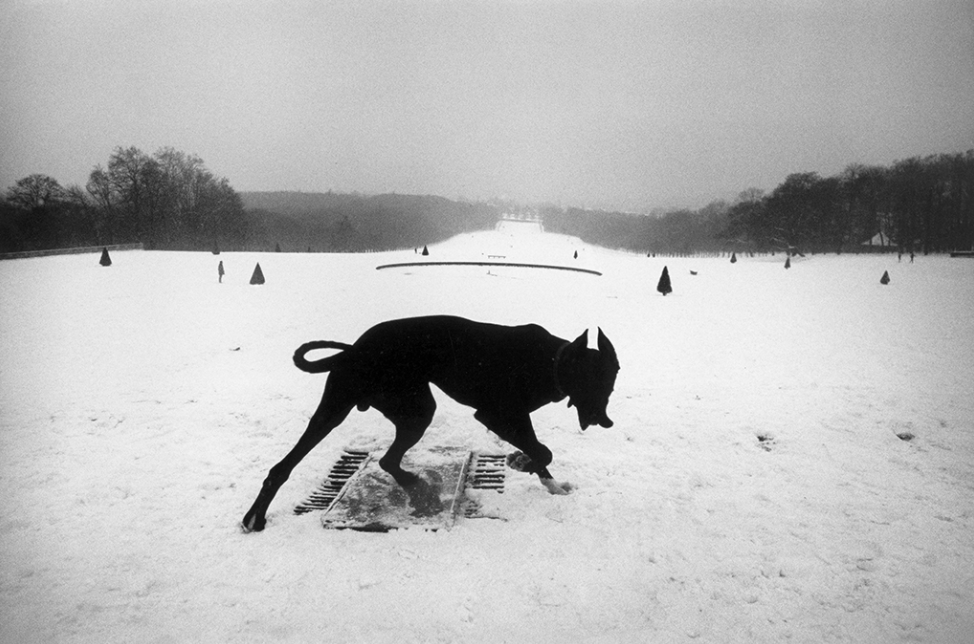We Are All the Same”: A Conversation with Josef Koudelka
The Czech-born photographer on freedom, landscape, empathy—and why good photographs are so rare

Josef Koudelka in the Getty Center galleries, November 2014
Josef Koudelka has been focusing an empathetic eye on the human condition for nearly six decades. The new exhibition Josef Koudelka: Nationality Doubtful presents a sweeping overview of his work, including poignant photographs of Roma (Gypsies), electrifying documents of the Soviet invasion of Czechoslovakia in 1968, and massive panoramas of conflict-altered landscapes, most recently from his project Wall on the West Bank barrier and the land that surrounds it on both sides.
He spoke to us during the final moments of preparation for the exhibition.

France, negative, 1987; print, 1987-88, Josef Koudelka, gelatin silver print. Image courtesy of Josef Koudelka and Pace/MacGill Gallery, New York. © Josef Koudelka/Magnum Photos
Laura Hubber: You’re famous for not taking assignments. How do you choose your subjects?
I know what I want to do and I do it. And I’ve created conditions so I can do it—I’ve been doing it for 45 years. People who do assignments are being paid and they are supposed to do something. I want to keep the freedom not to do anything, the freedom to change everything.
LH: What’s the main motivation for you to choose a subject?
I’m an intuitive person.
LH: If it speaks to you, you go.
You know, people ask all the time why I photographed gypsies. I’ve never known. I’m not particularly interested to know.
LH: Is it possible that you were drawn to the way Roma are free from the state?
No, not at all [pause]. You know, I didn’t grow up with American cinema like many photographers. I was from a little village. I was never fascinated by the United States. But I remember seeing photographs from the Farm Security Administration and they moved me very much. It wasn’t because of the style of the photography—it was because of the subject. Maybe you’ll find something similar with Gypsies too.
Annelisa Stephan: You’ve talked about having “the eye.” What does that mean?
When you look at something and think, this is right.
AS: So it’s a feeling?
Sure.
LH: How important is composition in your photographs?
It’s not a good photograph without good composition. Originally I’m an aeronautical engineer. Why do airplanes fly? Because there is balance.
A good photograph speaks to many different people for different reasons. It depends on what people have been through and how they react.
The other sign of good photography for me is to ask, “What am I going to remember?” It happens very, very rarely that you see something that you can’t forget, and this is the good photograph.

Prague, 1968, Josef Koudelka. Gelatin silver print, 5 3/4 x 9 in. Image courtesy of the Art Institute of Chicago, promised gift of private collector. © Josef Koudelka/Magnum Photos
LH: Tell us about photographing the Soviet-led invasion of Prague.
I’d just gotten back from Romania, where for months I was photographing Gypsies, and my friend called me and said, “The Russians are here.” I picked up the camera, went out on the street, and I photographed just for myself. I’d never photographed events before. These pictures weren’t meant to be published. Finally they were published one year later, which is interesting, because they weren’t news anymore.
AS: The exhibition includes several panoramas. What attracts you to this format?
I love landscape. But I was never happy photographing the landscape with a standard camera. In 1986 I was asked to participate in a government project in France. They invited me to the office and I saw a panoramic camera lying on the desk. I said, “Can I borrow this camera for one week?”
I ran around Paris; I had to photograph everything. I realized that with this camera I could do something I’d never done before. The panoramic camera helped me go to another stage in my career, in my work. It helped me to remain interested in photography, to be fascinated with photography.
I’m going to be seventy-seven. When I met Cartier-Bresson, he was sixty-two. I’m 15 years older than Cartier-Bresson was then. And at that time Cartier-Bresson was stopping his work with photography.
It’s not normal to feel that you have to do something, that you love to do something. If that’s happening you have to pay attention so you don’t lose it.
AS: In an interview at the Art Institute of Chicago you said you’ve “never met a bad person.” I see much empathy and love in your photographs.
That’s up to you [laughs].
AS: Are people fundamentally good?
I’ve been traveling 45 years without stopping, so of course things have happened to me that weren’t right. But even “bad” people behave a certain way because you don’t give them the opportunity to behave well. When you start to communicate with somebody, things go a different way.
AS: Can you give an example?
Have a look at the Russian soldiers [in my photographs of the Soviet-led invasion of Prague]. Okay, they were invaders. But at the same time, they were guys like me. They were maybe five years younger. As much as it might sound strange, I didn’t feel any hatred toward them. I knew they didn’t want to be there. They behaved a certain way because their officers ordered them to. I become friendly with some of them. In a normal situation, I’d have invited these guys to have a drink with me.
I can’t say I met one bad person [while photographing] in Israel either. Once I was in East Jerusalem with a photographer friend who went with me. We were planning to eat sandwiches under the trees. Suddenly, soldiers ran over with guns. One of them hit and broke my camera. But when I looked in his face, he had the same fear as the Russian soldiers in ‘68. I’m sure if I’d had the opportunity to talk to this guy, he would never have done that.

Al ‘Eizariya, negative 2010; print 2014, Josef Koudelka. Inkjet print, 26 3/4 x 81 7/8 in. Image courtesy of and © Josef Koudelka/Magnum Photos
LH: To be a wonderful photographer, you have to have empathy for the human condition.
We are all the same. And we are composed from the bad and the good.
LH: May we ask you to comment on a few of your photographs?
I wouldn’t talk about the photographs. No, I try to separate myself completely from what I do. I try to step back to look at them as somebody who has nothing to do with them.
When I travel, I show my pictures to everybody—to see what they like, what they don’t like. A good photograph speaks to many different people for different sorts of reasons. And it depends what sort of lives these people have. What they’ve gone through. It happens very rarely that you see something you can’t forget. That is a good photograph.
LH: What’s the role of the professional photographer today, when everyone is empowered to take photographs?
I think it’s wonderful that everybody can take photographs, just like I think it’s wonderful everybody can write. But there are very few writers and there are very few photographers.
Everybody has a camera, everybody can press the button. Everybody has a pencil, everybody can make a signature. But that doesn’t mean there are many great writers and it doesn’t mean there are many great photographers.
AS: What do you see as the difference between photography and art?
I never use the expressions “art” or “artist.” In Israel we were stopped every day, sometimes five times a day, when we were photographing. Once my friend turned to the soldiers and he said, “He’s not a reporter, he’s an artist!”
I’ve only said I’m am artist once—when I nearly got into trouble in Algeria [laughs]. If I said I’m a photographer, I would really get into trouble. If you’re artist, you’re all right.
AS: Why don’t you call yourself an artist?
I’m a photographer, that’s all. Like anything else, not all paintings are art. Not all photographs are art. They might be, but it’s not up to me to say.




